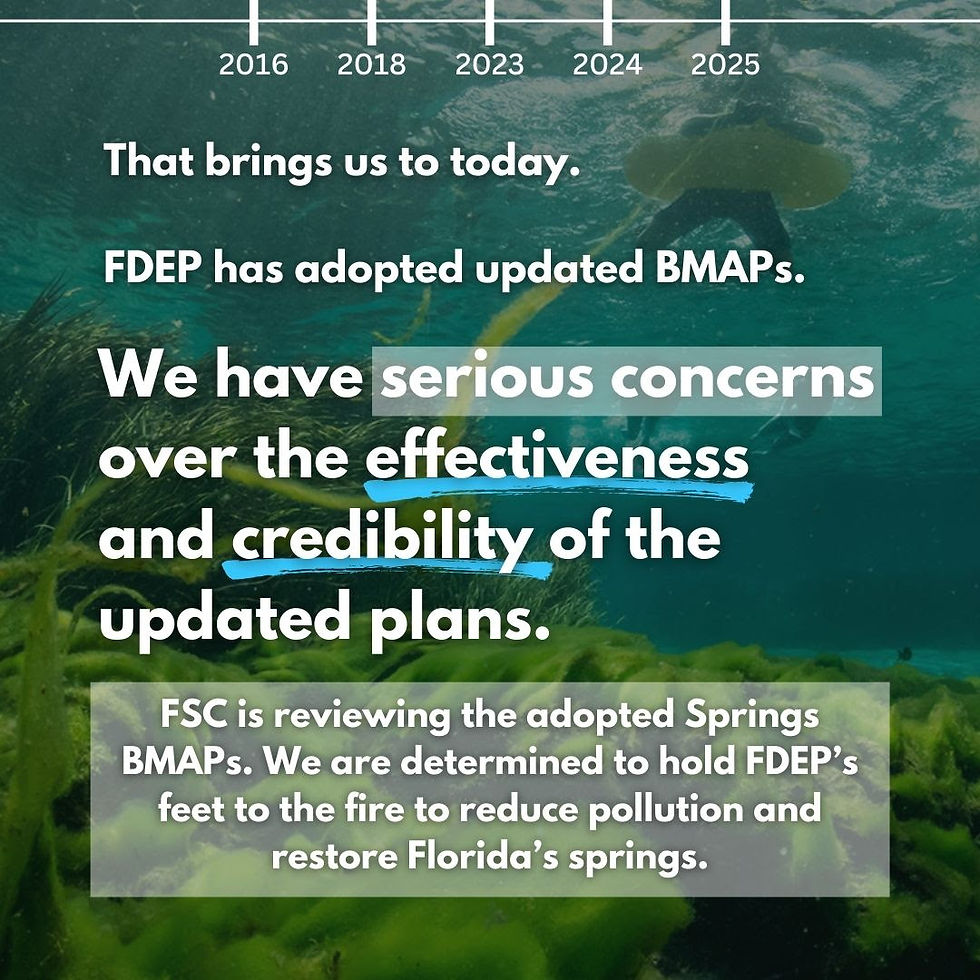FDEP's Plans to Clean Up Springs: What You Need to Know
- Chloe Dougherty

- Jul 25, 2025
- 2 min read

We’re here to help you become the best Springs Advocate you can be.
It’s essential for Springs Advocates to become familiar with the state’s water quality restoration plans, called Basin Management Action Plans, or BMAPs.
The acronym makes it sound technical, but it’s really simple: Springs BMAPs are the only regulatory tool Florida has to reduce pollution in springs.
With nearly 90% of Outstanding Florida Springs impaired by nitrogen pollution, and pollution in springs still increasing, you can see why it’s so critical for FDEP’s plans to work.
If you love, and want to help protect, Florida’s springs, it’s important to understand BMAPs, so you can hold FDEP accountable to upholding the law and restoring Florida’s Springs.
Here’s what you need to know
What the heck is a BMAP?
In 2016, a new law required FDEP to create BMAPs for all impaired Outstanding Florida Springs to achieve water quality goals within 20 years.
The goal of a BMAP is simple on paper:
→ Identify where the pollution is coming from and who is responsible for reducing it
→ Set goals and deadlines, and plans and projects to reach those deadlines
→ Restore springs water quality to acceptable levels



So what’s the problem?
Long story short, FDEP is the problem. The first Springs BMAPs came out in 2018. Since then nitrogen in these springs has increased by over 1.5 million pounds per year.
FSC and our partner organizations could see that the plans weren’t going to work:
🥴 FDEP Math: It wasn’t enough. The plans stopped short of reaching the nitrogen reductions required by law, often less than a quarter.
🚧 Built for the Past: They used 2017 population data like Florida stopped growing then. No plans to factor in increased pollution from inevitable growth.
🌾 Ag Got a Free Pass: Agriculture is the largest source of nutrient pollution and most springs will never recover without real plans to help. These plans barely addressed it.
So the Florida Springs Council members took the state to court. After four years, we won. The judge ruled that FDEP had to fix the plans by clearly identifying pollution sources and outlining how they would be reduced.



What’s happening now?
FDEP adopted updated BMAPs a few weeks ago. We’re examining the plans carefully and can see that they still fall short. They include vague strategies, lack accountability, and most importantly, will not restore polluted springs back to health.The Florida Springs Council is determined to hold FDEP accountable and secure meaningful plans to clean up our algae-choked springs.
Why this matters:
BMAPs are the only enforceable tool to stop springs pollution. If they don’t work, our springs continue to degrade.
As a Springs Advocate, understanding Springs BMAPs is essential.
You can help put pressure where it matters and be an advocate for your local spring. We’re here to help you be that advocate, and we will keep you updated on the process as it unfolds.
Want to learn more?
We’ve put together an opportunity for a deep dive into Springs BMAPs, including a spring-by-spring update, here: floridaspringscouncil.org/springsbmaps





